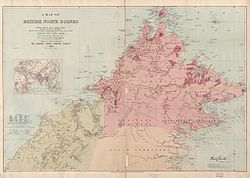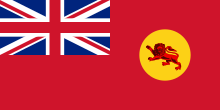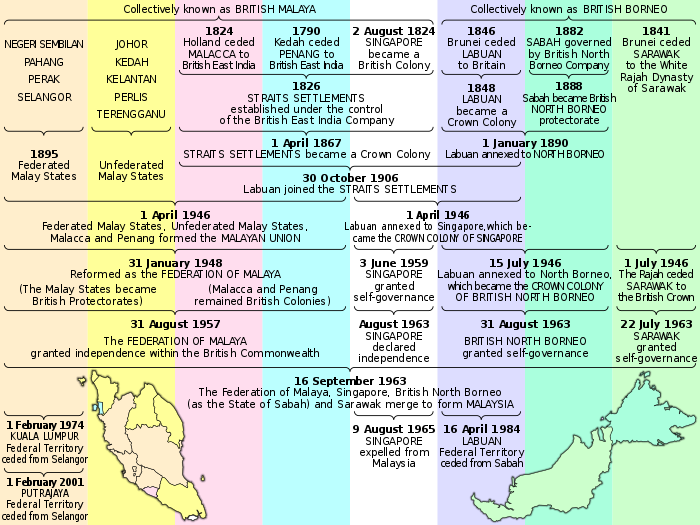North Borneo
This article needs additional citations for verification. (July 2013) |
North Borneo Borneo Utara | |||||||||||||||||
|---|---|---|---|---|---|---|---|---|---|---|---|---|---|---|---|---|---|
| 1882–1941 1945–1946 | |||||||||||||||||
| Motto: (Latin: Pergo et Perago) "I undertake and I achieve" | |||||||||||||||||
| Anthem: God Save the King/Queen | |||||||||||||||||
 British North Borneo border, 1899. | |||||||||||||||||
| Status | Protectorate of the United Kingdom | ||||||||||||||||
| Capital | Sandakan (pre war); Jesselton (post war) | ||||||||||||||||
| Common languages | English, Kadazan Dusun, Bajau, Murut, Sabah Malay, Chinese etc. | ||||||||||||||||
| Government | Protectorate, Crown Colony | ||||||||||||||||
| Governor | |||||||||||||||||
• 1896–1901 | Robert Scott (North Borneo) | ||||||||||||||||
| Historical era | New Imperialism | ||||||||||||||||
| May 1882 | |||||||||||||||||
• Protectorate | 1888 | ||||||||||||||||
| 1 January 1942 | |||||||||||||||||
| June 1945 | |||||||||||||||||
• Restored as Colony | 18 July 1946 | ||||||||||||||||
| 16 October 1947 | |||||||||||||||||
| 31 August 1963[1][2] | |||||||||||||||||
| 16 September 1963[3] | |||||||||||||||||
| Area | |||||||||||||||||
| 1936 | 76,115 km2 (29,388 sq mi) | ||||||||||||||||
| Population | |||||||||||||||||
• 1936 | 285,000 | ||||||||||||||||
| Currency | North Borneo dollar, until 1953 Malaya and Borneo dollar, after 1953 | ||||||||||||||||
| |||||||||||||||||
| Today part of | |||||||||||||||||
North Borneo was a British protectorate located in the northern Borneo which was under the sovereign North Borneo Chartered Company from 1882 to 1941. From 1942 to 1945, North Borneo was occupied by Japanese military forces, before they were driven out by Australian troops. From 1946[5] to 1963, North Borneo was turned into a Crown Colony of Great Britain, known as British North Borneo Crown. During the time also seven of the British-controlled islands in north-eastern Borneo named Turtle Islands together with Cagayan de Tawi-Tawi were ceded to the Philippine government under a past treaty signed between the United Kingdom and the United States.[6] Today, the former North Borneo is part of Malaysia as the state of Sabah, apart from the island group of Labuan which was separated from the rest in 1984 to form a Federal Territory, administered directly from the federal government.
History
North Borneo Company
Before the eastern part of the territory was ceded by the Sultanate of Brunei to the Sultanate of Sulu as a gift for helping the Bruneian forces during a civil war that happened in Brunei, the whole territory was once under the rule of the Bruneian Empire.[7][8] In 1761, British East India Company officer Alexander Dalrymple concluded an agreement with the Sultan of Sulu to allow him occupation of Balambangan Island, located 51 km off the coast of Kudat and known to the British as Felicia Island.[9] A free port was then established here which was of importance for the interest of Britain in the east Asia region, namely, trade with China. The port however failed to become a long term success due to constant pirate attacks as well as other reasons and the British left in 1805.

In 1865, the United States Consul to Brunei, Charles Lee Moses, obtained a 10-year lease for the territory of North Borneo from the Sultan of Brunei. However, the post-Civil War United States wanted nothing to do with Asian colonies, so Moses sold his rights to the Hong Kong-based American Trading Company of Borneo owned by Joseph William Torrey, Thomas Bradley Harris, Tat Cheong and possibly other Chinese merchants. Torrey began a settlement at the Kimanis River mouth, which he named Ellena. Attempts to find financial backing for the settlement were futile, and disease, death and desertion by the immigrant labourers led to the abandonment of the settlement towards the end of 1866. Harris died in 1866 and Torrey returned to America in 1877. He died in Boston, Massachusetts, in March 1884.


With the imminent termination of the lease at hand in January 1875, Torrey managed to sell his rights to the Consul of the Austro-Hungarian Empire in Hong Kong, Baron Gustav von Overbeck. Von Overbeck managed to get a 10-year renewal of the lease from the Temenggong of Brunei, and a similar treaty from the Sultan of Sulu on 22 January 1878. To finance his plans for North Borneo, Overbeck found financial backing from the Dent brothers (Alfred and Edward). However, he was unable to interest his government in the territory. After efforts to sell the territory to Italy for use as a penal colony, von Overbeck withdrew in 1880, leaving Alfred Dent in control. Dent was supported by Sir Rutherford Alcock, and Admiral Sir Harry Keppel. In July 1881, Alfred Dent and his brother formed the British North Borneo Provisional Association Ltd and obtained an official Royal Charter 1 November the same year. In May 1882, the North Borneo Chartered Company replaced the Provisional Association. Sir Rutherford Alcock became the first President, and Alfred Dent became Managing director. In spite of some diplomatic protests by the Dutch, Spanish and Sarawak governments, the North Borneo Chartered Company proceeded to organise settlement and administration of the territory.
The company subsequently acquired further sovereign and territorial rights from the sultan of Brunei, expanding the territory under control to the Putatan river (May 1884), the Padas district (November 1884), the Kawang river (February 1885), the Mantanani Islands (April 1885), and additional minor Padas territories (March 1898). The company also established a foundation for economic growth in North Borneo by restoring peace to a land where piracy and tribal feuds had grown rampant. It abolished slavery and set up transport, health and education services for the people. Chinese immigrants were wooed to boost the small population of less than 100,000. Through the combined effort of the locals and immigrants, towns, farms, a timber industry, tobacco and rubber plantations began to thrive.
Protectorate of Britain

In 1888, North Borneo became a protectorate of Great Britain, but its administration remained entirely in the hands of the North Borneo Chartered Company, with the crown reserving only control of defence and foreign relations. From 1890 to 1905 the British government placed the colony of Labuan under the administration of North Borneo. The Company's rule in North Borneo had great impact on the development of the region. Although was generally peaceful, the local population occasionally resented the imposition of taxes and the loss of land to European plantations. The most serious resistance was the Mat Salleh (Mahomet Saleh) War from 1894 to 1900, and the Rundum Uprising by the Murut in 1915.
The Chartered Company's system of administration was based on standard British colonial administration structures, with the land divided into Residencies, and sub-divided into Districts. Initially, there were only two Residencies: East Coast and West Coast, with Residents based at Sandakan and Jesselton respectively. Each Residency was divided into Provinces, later known as Districts, which were run by District Officers. By 1922, there were five Residencies to accommodate new areas that were opened up for development. These were the West Coast, Kudat, Tawau, Interior and East Coast Residencies. These Residencies were in turn divided into 17 Districts. Under this system, British held top posts, while native chiefs managed the people at grassroots level. This was not a conscious attempt by the British to instil indirect rule but a convenient arrangement for the district officers who were unfamiliar with local customs and politics.
The North Borneo Chartered Company effectively ruled until 1 January 1942. Japanese forces occupied North Borneo from 1942 to 1945. The North Borneo Armed Constabulary with only 650 men hardly provided any resistance to slow down the Japanese invasion. During Japanese military occupation, the Europeans were interned, public services ceased to exist, and there were widespread poverty, disease and malnutrition. In June 1945, the Australian 9th Division landed in Brunei and liberated much of North Borneo before the end of the war. North Borneo was placed under British Military Administration until restoration of civil government on 15 July 1946.
Crown Colony of British North Borneo
| History of Malaysia |
|---|
 |
|
|

The North Borneo Chartered Company did not have the financial resources to reconstruct North Borneo after the destruction of World War II. The major towns had been razed to the ground by Allied bombing, and the infrastructure of North Borneo was in total devastation. The North Borneo Chartered Company decided to sell its interests to the British government. The territory was placed under control of the colonial office, and became a British crown colony on 15 July 1946 together with islands of Labuan. The destruction of the former capital Sandakan was so complete that Jesselton was chosen as the new post-war capital. The colonial system of administration was in most ways similar to rule during the Company era, retaining the same Residency and District structure; however, as a result of this change in status, North Borneo had access to British government funds for reconstruction. A Governor and Commander-in-Chief was appointed to administer the colony of North Borneo with the assistance of an Advisory Council consisting of three ex officio members: a Chief Secretary, the Attorney-General, and the Financial Secretary, together with other members both official and unofficial whom the Governor chose to appoint. In 1950, the Advisory Council was replaced by the Executive and Legislative Councils.[citation needed]
The Executive Council functioned as a Cabinet and was headed by the Chief Secretary. In addition to the Attorney General and the Financial Secretary, it consisted of two officials and four nominated members. The Governor presided at the Executive Council meetings and he alone was entitled to submit questions to the Council. The Legislative Council consisted of the Governor as President, the usual three ex officio members, nine official members and ten nominated members. The high-ranking administrative posts continued to be held by the British, and in fact, it was only in 1957 that the first non-European filled an administrative officer's post. The British North Borneo was granted self-government on 31 August 1963 in Keningau to prepare for a merger with the Federation.[2] A little over two weeks later, on 16 September 1963, the state united with Malaya, Sarawak and Singapore, forming the Federation of Malaysia.[2] The First Natives Paramount Leader was Pehin Orang Kaya-Kaya Koroh Santulan of Keningau "The father of former Sabah State Minister Tan Sri Stephen (Suffian) Koroh, and Sabah's fifth State Governor Tun Thomas (Ahmad) Koroh (the elder brother of Suffian)". Santulan which also a Pengeran, the father to Pehin Orang Kaya-Kaya Koroh was a Murut descendant of Hashim Jalilul Alam Aqamaddin, the 25th Sultan of Brunei.[citation needed]
Timeline of the history of Malaysia

See also
- Governor of North Borneo
- History of Sabah
- British North Borneo dollar
- Malaya and British Borneo dollar
- Manila Accord
- Postage stamps and postal history of North Borneo
References
- ^ Oxford Business Group. The Report: Sabah 2011. Oxford Business Group. pp. 13–. ISBN 978-1-907065-36-1. Retrieved 26 May 2013.
{{cite book}}:|author=has generic name (help) - ^ a b c Frans Welman. Borneo Trilogy Volume 1: Sabah. Booksmango. pp. 159–. ISBN 978-616-245-078-5. Retrieved 28 May 2013.
- ^ Agreement relating to Malaysia between United Kingdom of Great Britain and Northern Ireland, Federation of Malaya, North Borneo, Sarawak and Singapore
- ^ Malaysia Act 1963. Retrieved on 12 August 2011.
- ^ "Sabah" in The New Encyclopaedia Britannica. Chicago: Encyclopaedia Britannica Inc., 15th edn., 1992, Vol. 10, p. 278.
- ^ Peter C. Richards (6 December 1947). "New Flag Over Pacific Paradise". The Sydney Morning Herald. Retrieved 22 October 2015.
- ^ Muzium Brunei (1969). Brunei Museum Journal.
The area from Kimanis Bay to the Paitan River not from Sulu but from Brunei
- ^ Ben Cahoon. "Sabah". worldstatesmen.org. Retrieved 10 October 2014.
Sultan of Brunei cedes the lands east of Marudu Bay to the Sultanate of Sulu in 1704.
- ^ Howard T. Fry (1970). Alexander Dalrymple (1737-1808) and the Expansion of British Trade. Routledge. pp. 68–. ISBN 978-0-7146-2594-2. Retrieved 25 May 2013.
Further reading
- Discovering North Borneo, a short travelogue (2007). Author: Attila Urmenyhazi. National Library of Australia, Record ID 4272798 - Call Number: NLp 915 953 U77.
- British North Borneo : an account of its history, resources, and native tribes (1922)
External links
- A Trip Through British North Borneo A 1907 film.
- 1882 establishments in Asia
- 1882 establishments in the British Empire
- 1963 disestablishments in Asia
- 1963 disestablishments in the British Empire
- Disputed territories in Asia
- Borneo
- British North Borneo
- British rule in Malaysian history
- Former British protectorates
- Former countries in Borneo
- Former countries in Bruneian history
- Former countries in Malaysian history
- Former British colonies and protectorates in Asia
- Former Austrian colonies
- British Borneo
- History of Brunei
- History of Sabah
- Maritime Southeast Asia
- States and territories established in 1882
- States and territories disestablished in 1963
- Territorial disputes of the Philippines




